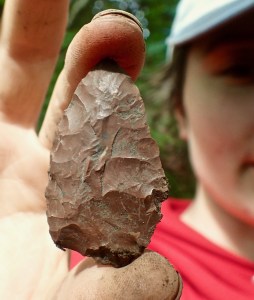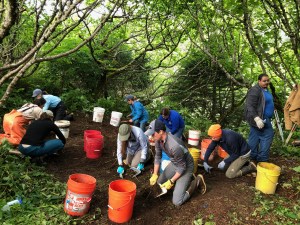
Every summer, the Alutiiq Museum and Archaeological Repository hosts a community project in Kodiak. Students and community members join in.
This season, they are excavating a site on a little island off Near Island, which appears to be a subsistence camp from thousands of years ago.
Down a trail through stands of towering Sitka spruce, across a rocky beach and along an outcropping, is a freshly dug four-by-five-meter patch of dirt where researchers believe that thousands of years ago Alutiiq people once caught and smoked cod.
“So, we are at the archaeological site called Qik’rtangcuk,(which means little island in Alutiiq,)” Molly Odell, a project manager and archaeologist at the museum, said.
It is day three of community archaeology and, through the filtered light of an alder canopy, the all-volunteer team of 10 is uncovering a large fire pit – about three meters across. Initial discoveries point to the site being a seasonal camp.
“We have not found any evidence of houses or people living here,” Odell said. “So, it probably was more like a camp… and Patrick, my colleague, was out here hiking one time and he saw some people catching cod right from the beach, and this was just a few years ago. So, we know that you can catch cod here today, so you probably could a few thousand years ago as well.”
They’ve already dug up a fist-sized rock fishing line weight, called a plummet, which indicates the site could be around 3,000 years old.
Patrick Saltonstall is Curator of Archaeology at the Alutiiq Museum.
“Archeology is all about using evidence to come up with what happened in the past. The story is what really matters,” Saltonstall said.
As Saltonstall explained, a big part of figuring out the story comes from mapping the site. He calls out measurements: 106, 113, 110.
“It is elevation in relation to data. So, we’ll be able to make a three-dimensional map of the site,” Saltonstall said.
Peter Ellis is a Ph.D student in archaeology at the University of Pittsburgh who traveled all the way to Kodiak to volunteer on the project.

“I’ve never dug anything this old before. This is very cool to me. Again, back on the east coast, everything was 17-1800s for me,” Ellis said. “The oldest thing was probably 1400 AD. So, this is a kind of a really cool, unique opportunity. I have never seen a feature, like a smoke processing pit, that size either, before.”
Ellis worked on another community archaeology dig in Dutch Harbor last summer. He’s an experienced digger who says the way you dig matters.
“So, basically, with archaeology, we’re looking at time as it goes down through the soil. So, you want to dig mostly horizontally, thin layers at a time,” Ellis said. “So, if you look for any changes you might find them by digging horizontally, slowly, instead of kind of digging, you know, one deep pit straight down. So, that is where we use the trowels and the dustpans to slowly scoop dirt into our dustpans and put them in the bucket, and then we give them to our screener, who is going to run all that sediment through a screen to catch any artifacts bigger than a quarter inch or a half inch.”
The very first day of the dig, volunteer Keith Bruce, a sophomore at Kodiak High school, found the artifact mentioned earlier — the fishing weight.
“The first day I found a stone plummet, which was used to hold down fishing line. It was a weird feeling. You know you’re touching something someone touched 3,000 years ago, 4,000 years ago,” Bruce said. “It feels special because you can see where someone has hit it, spent time knocking it around making the groove.”
But in between, it is a lot of digging until that magical moment when your eye spots something.
“I’m starting to find soil that has little tiny white flecks in it, which I think are degraded shells, like clam shells, things like that,” Odell said. “And then I found some little tiny pieces of fish bones here, which is what we were hoping to find because we were thinking this was a smoking pit for fish.”
And then the crew finds something else: another plummet, which Patrick Saltonstall described.
“A line weight or a net weight. It’s notched, a rock here that looks kind of ugly, but it is notched on either end, and this probably would have a line around it in order to — held a rig for fishing on the bottom,” Saltonstall said. “This is how they caught the cod that they fished within here.”
Another clue that, hopefully, when added together with all the others, will create a small window into the world of Alutiiq people in Kodiak thousands of years ago.
KMXT intern Zane Navarro contributed to this story.
Daysha Eaton is a contributor with the Alaska Public Radio Network.
Daysha Eaton holds a B.A. from Evergreen State College, and a M.A. from the University of Southern California. Daysha got her start in radio at Seattle public radio stations, KPLU and KUOW. Before coming to KBBI, she was the News Director at KYUK in Bethel. She has also worked as the Southcentral Reporter for KSKA in Anchorage.
Daysha's work has appeared on NPR's "Morning Edition" and "All Things Considered", PRI's "The World" and "National Native News". She's happy to take assignments, and to get news tips, which are best sent via email.
Daysha became a journalist because she believes in the power of storytelling. Stories connect us and they help us make sense of our world. They shed light on injustice and they comfort us in troubled times. She got into public broadcasting because it seems to fulfill the intention of the 4th Estate and to most effectively apply the freedom of the press granted to us through the Constitution. She feels that public radio has a special way of moving people emotionally through sound, taking them to remote places, introducing them to people they would not otherwise meet and compelling them to think about issues they might ordinarily overlook.




